Fleets and Exploiting the Empire
2021. August 19.
In last week’s spotlight, the designers took a closer look at Conquest and Corruption, how you expand your Empire by seizing sectors, and the insidious impact of the Voidborn. Today, it’s time to talk a bit about our fleets and the eXploit part of the 4X euro game of Voidfall.
Over the course of our many test games of Voidfall, we’ve discovered that the best way to teach it is to start with its concepts rather than deep diving into rules. As soon as someone is familiar with the game concepts and how they interlock, the theme and the UI helps the rules to just “click” together. This conceptual approach is what we took in writing not only these design spotlights, but also the rulebook. If you’ve been following along, you already know a lot of these concepts: Population and Production, Techs and Agendas and the Voidborn and Corruption. Today, it’s time to take a look at the Fleets and Fleet Power!
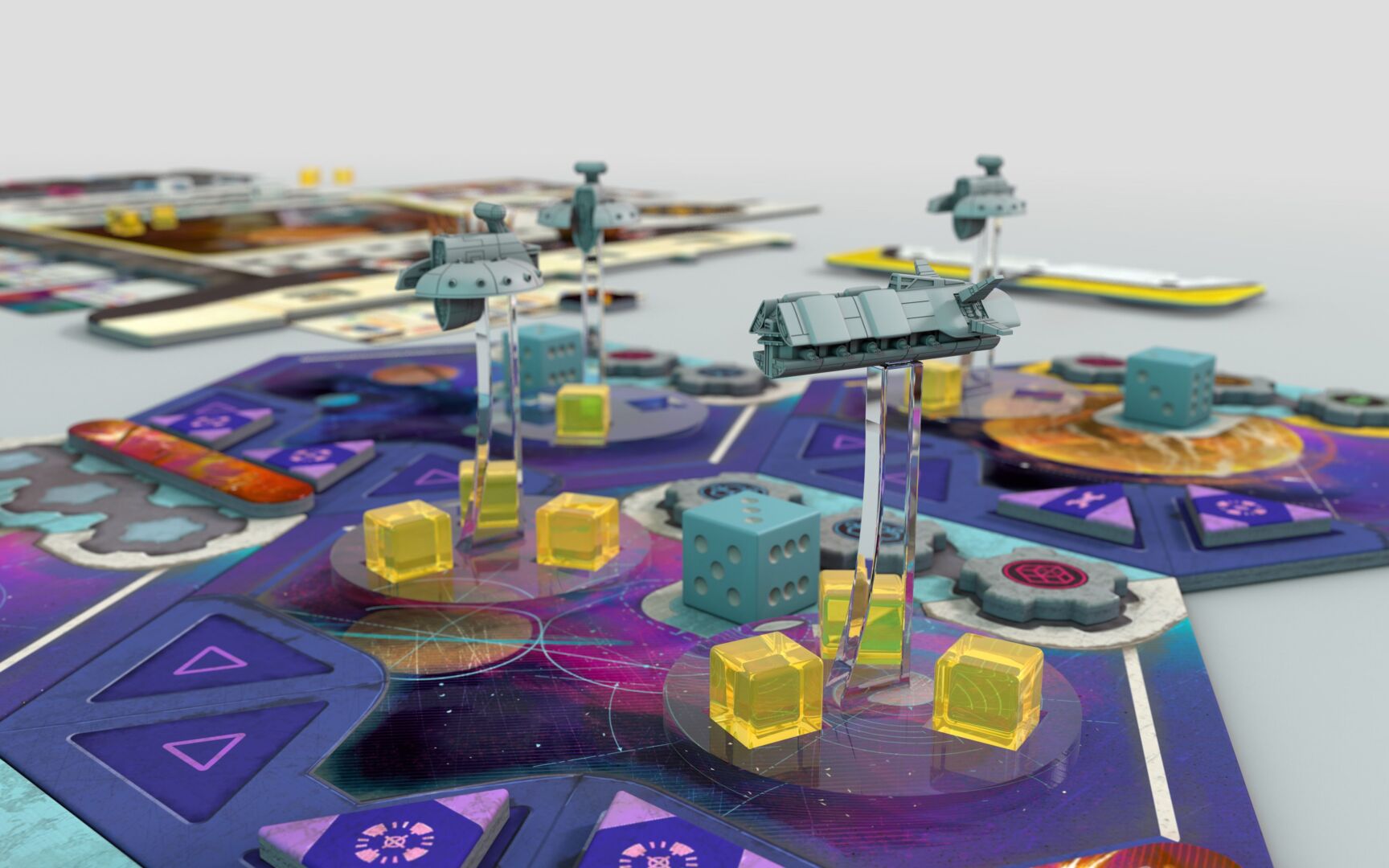
Just like with the rest of the concepts that we’ve introduced so far, Voidfall takes a zoomed-out, grand scale approach in how it handles Fleets. Each Fleet represents dozens to hundreds of ships tasked with a similar purpose, and each Fleet Power is an abstraction of your capabilities to keep an interstellar fighting force together: the hardware, the crew, the armaments and the support infrastructure such an armada requires. Therefore, your Fleet Power never “dies”, if it loses the capability to fight (in battle, or you recall it as a cost), the marker simply returns to your player board. Think of it this way: the materials you’ve spent deploying the ships are not coming back to you, but just because you lost a battle, you haven’t forgotten how to field and command a space navy across several sectors. This logistical limitation is what the Fleet Power represents.
Corvette Fleets are the backbone of your House, but there are four other Fleet Types that can be introduced to your game via Techs: Sentries help you defend your sectors; Destroyers spearhead your offense, Dreadnaughts are behemoths that are very hard to take down, and Carriers deploy additional Fleets to the front lines.

Here are two fleets of different types that might be in the service of your House’s navy.
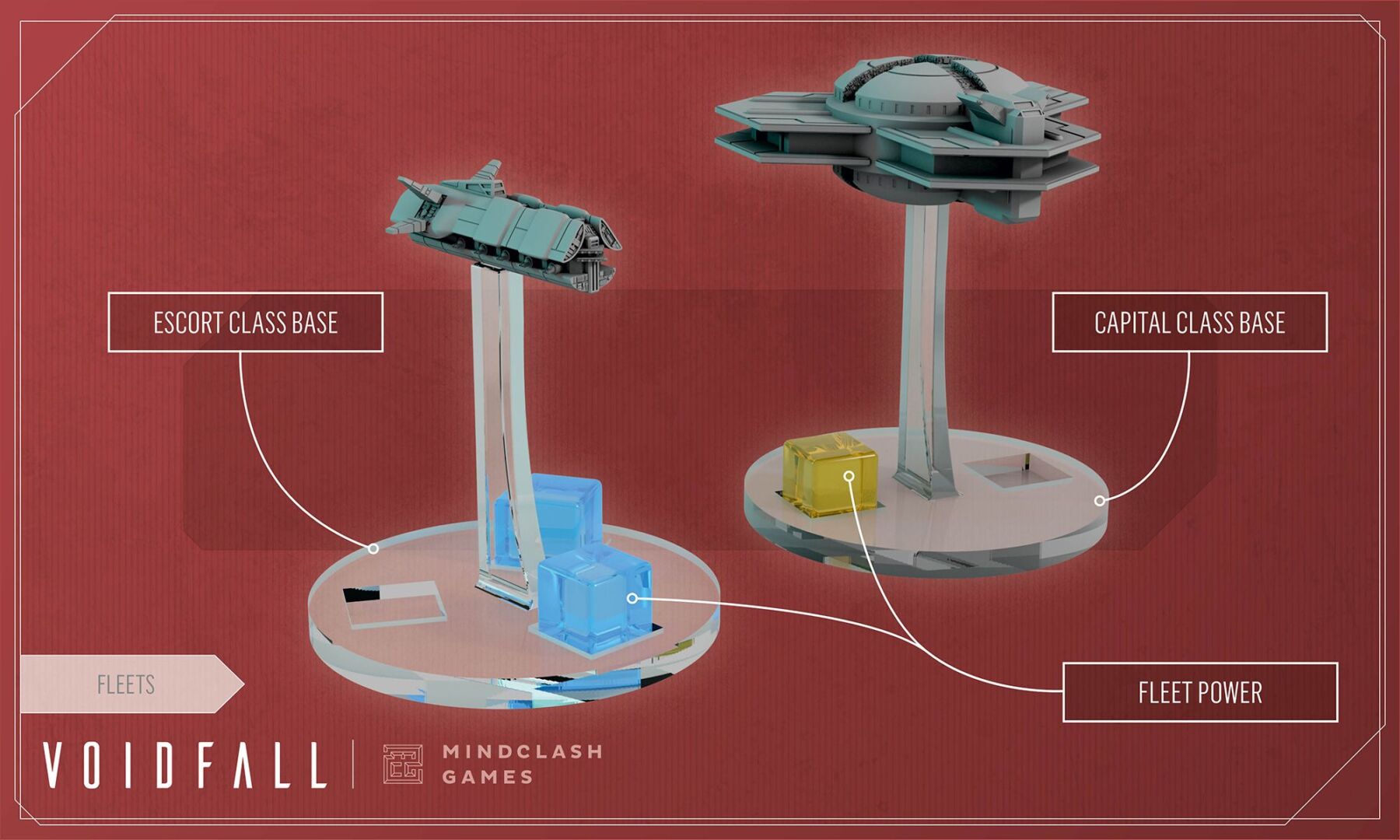
On the left, we see a Corvette Fleet with 2 Power and next to it a Carrier Fleet with a Power of 1.
Fleet Power markers are the only player coloured components on non-home Sectors. You need them to maintain ownership of your sectors, you need them to expand, and you are very limited both in how many are available (usually 5 or 6 at the beginning of the game), and in how many you can possibly get (you are hard capped in 14).
The stand of the Fleet shows the maximum capacity of that fleet type. As you can see above, escort class fleets (Corvette and Sentry) can have a maximum fleet power of 3, while capital class fleets (Destroyer, Dreadnaught and Carrier) only have spaces for 2 cubes on their base.
Fleet Types other than Corvettes require you to gain the relevant Tech first. So to deploy Carriers you need the Carriers Tech, and if you get the Improved version of it you can upgrade all your present and future Carrier fleets to a stronger version. We will show some example differences between the Fleet types in an upcoming spotlight, and walk you through how Combat works!
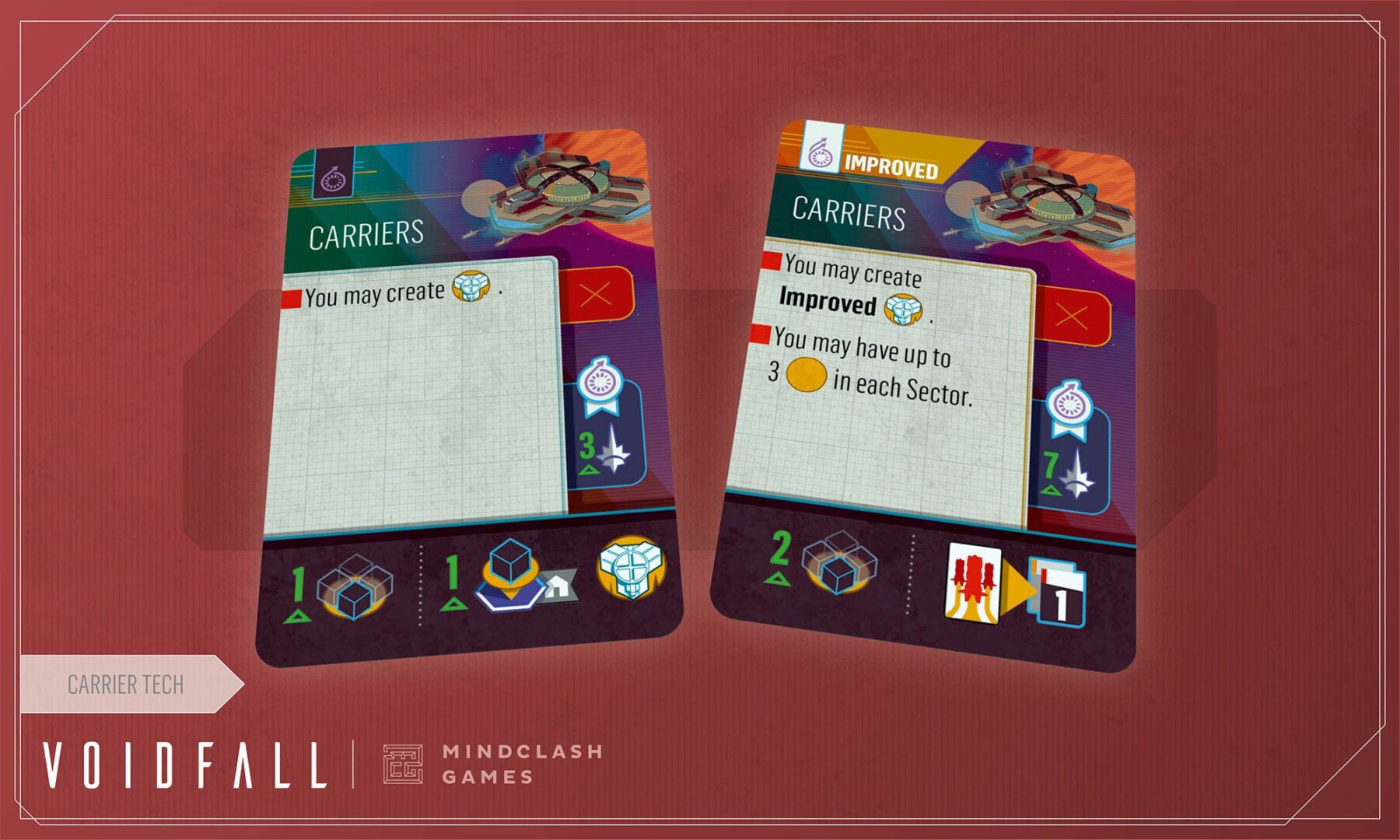
When you expand and battle either against your opponents or the Voidborn, you will take losses. As we’ve mentioned, such losses are not permanent - you can deploy previously recalled power markers to your sectors, and replace your losses. This Fleet Deployment represents the build up and refit of your navy over time. But if you plan to have a large empire with a strong military, you will also need to gain more fleet power beyond your starting capacity, not just to expand but to maintain control of multiple Sectors.
You will need to build fleets for future invasions and to ensure you are strong enough to repel possible invaders, either with your fleets or by constructing Sector Defenses. The focus card you need for this is Reinforcements.
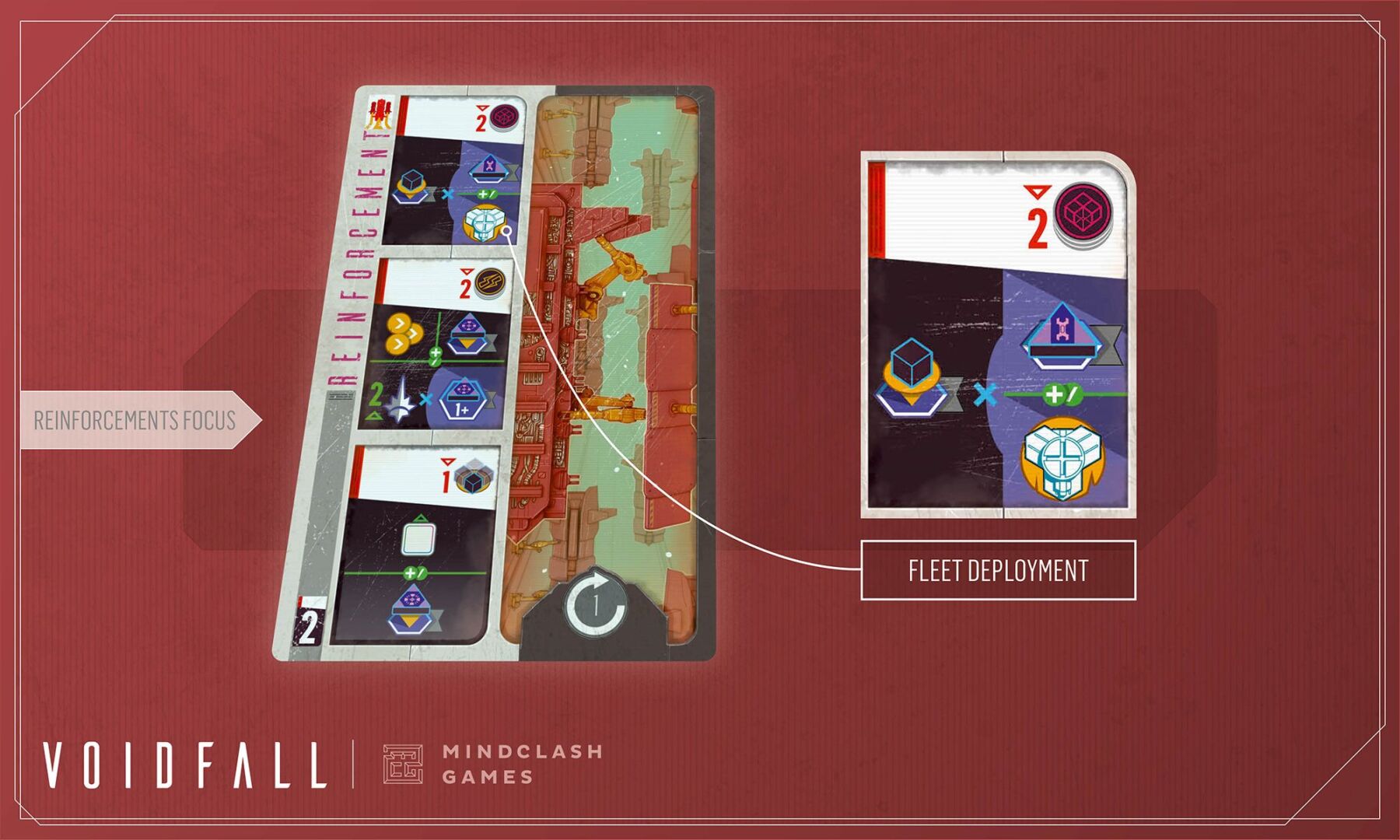
Fleet Deployment is the obvious choice for boosting your fleet. For the cost of 2 materials you can deploy a Fleet Power at every Shipyard you control and at every Carrier. Deployed Fleet Power can be placed into an existing Fleet’s base (increasing its strength), or you can take a new base and a new Fleet corresponding to your desired Fleet Type and place the Power in there, essentially starting a new Fleet. With the right Tech, you can even boost this further, ensuring that you have a steady supply of full strength fleets for future invasions or defense.
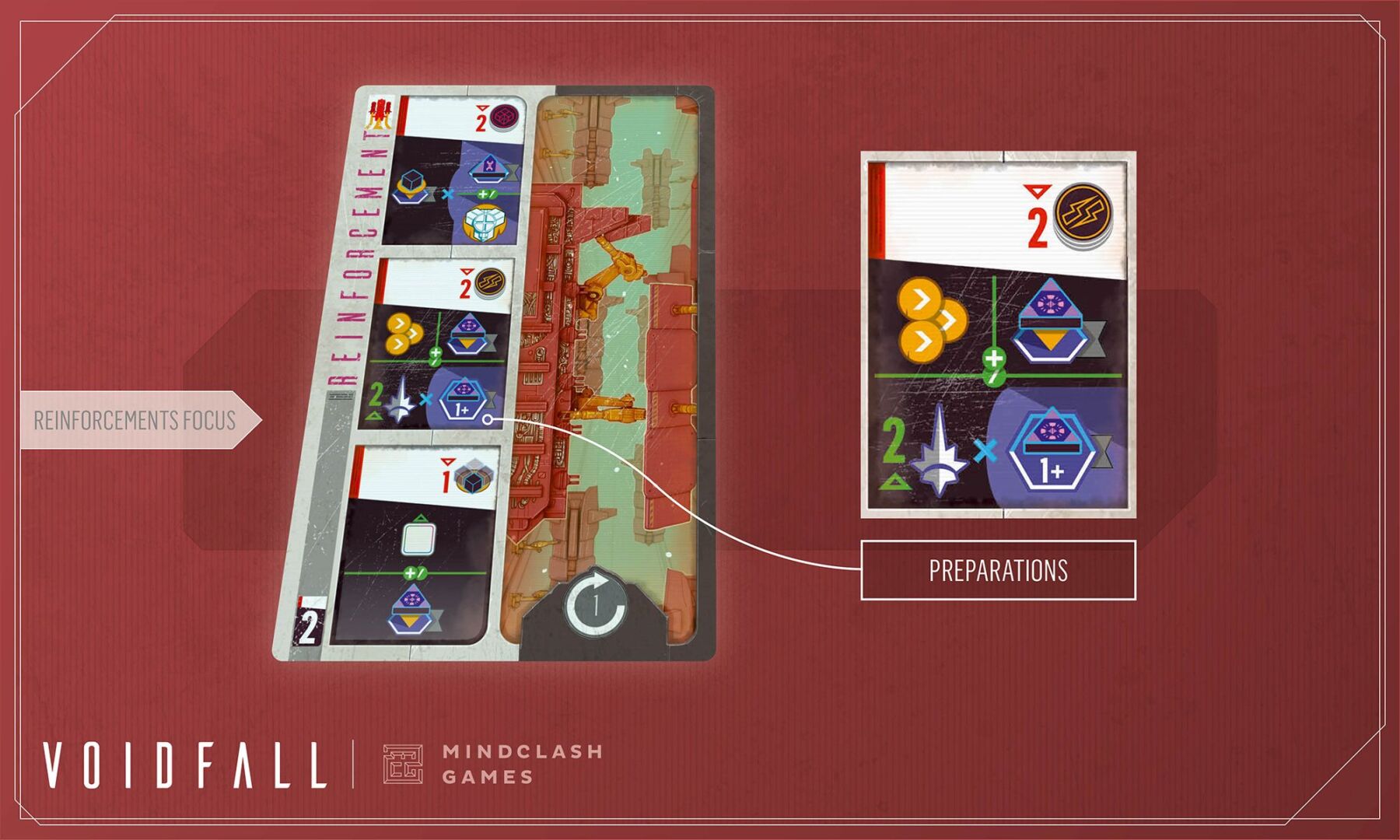
The second action on the Reinforcements Focus is Preparations. Like the previous choice, it allows you to add some muscle where you need it most, but rather than deploying more Fleet Power, this action gives you the chance to regroup existing fleets. For the cost of 2 energy you can move up to 3 different fleets. This is similar to the movement in Conquest, but instead of invading an opposing sector you get to move a fleet between two adjacent sectors you control. In addition, you can also build a Sector defense (more about how they work in the next spotlight), and gain 2 Influence for each Sector where you have at least one Defense built. This might seem a small reward for your effort, but especially when combined with defensive-focused Agendas, you can really reap the benefits of multiple Sector Defenses on the long run.
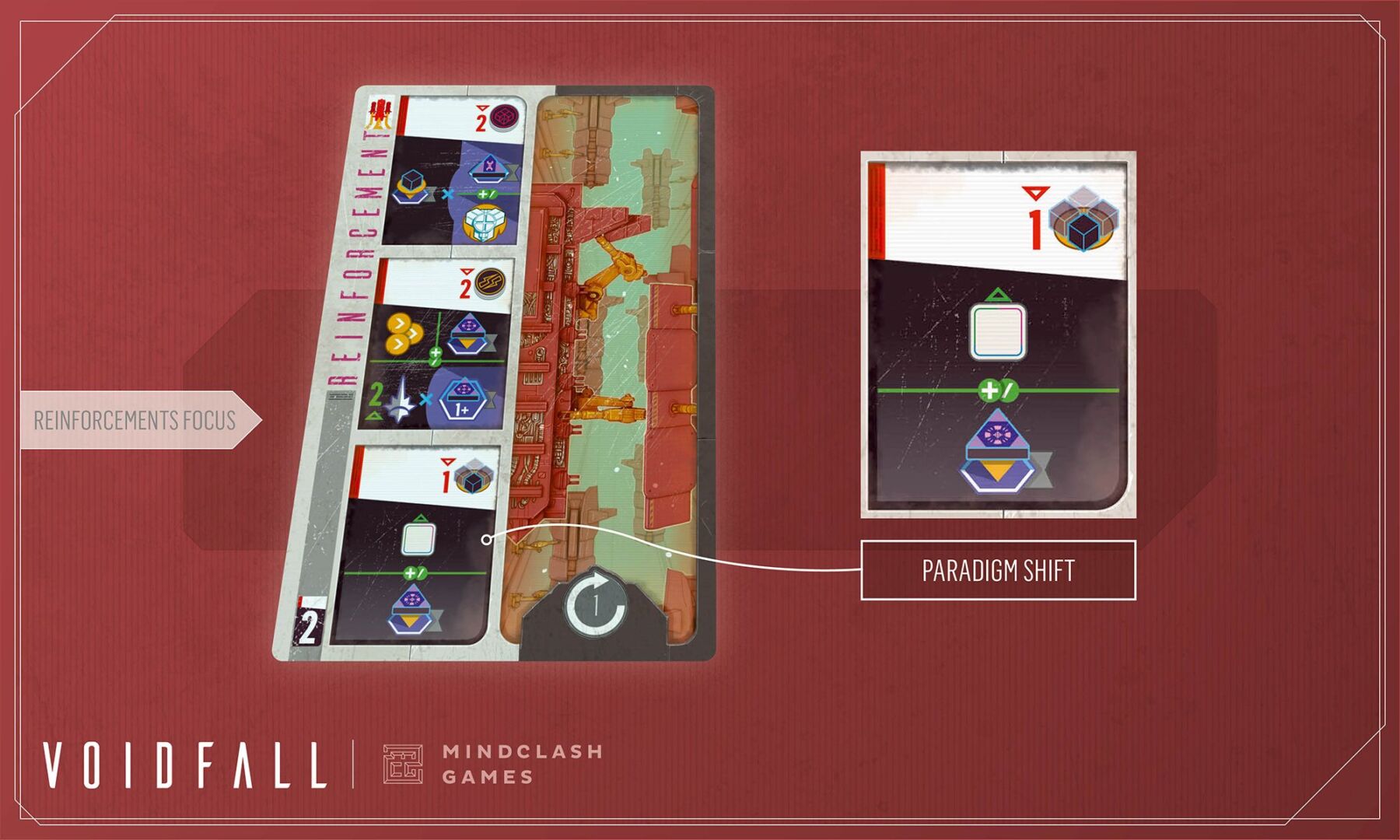
The final action on Reinforcements is an interesting and different way of exploiting your military power. Instead of deploying more fleets, you may decide to find peaceful applications to some of your military infrastructure and logistics capability. By permanently giving up a Fleet Power from your reserve, this Paradigm Shift allows your House to advance towards a new Era in the three different, asymmetric House tracks. More on those in a later spotlight, when we show you the House asymmetries along with different aspects of their culture!

With all these concepts under our belt, we have come far: we’ve populated our early sectors, deployed mighty fleets, expanded, and liberated millions from the Voidborn’s grasp. Now that your flourishing empire is brimming with population, Guilds and Installations, it is time to reap what you sowed! Let’s talk a bit about the many ways of Voidfall’s third X, eXploit, starting with the most apparent one: the Production Focus card.
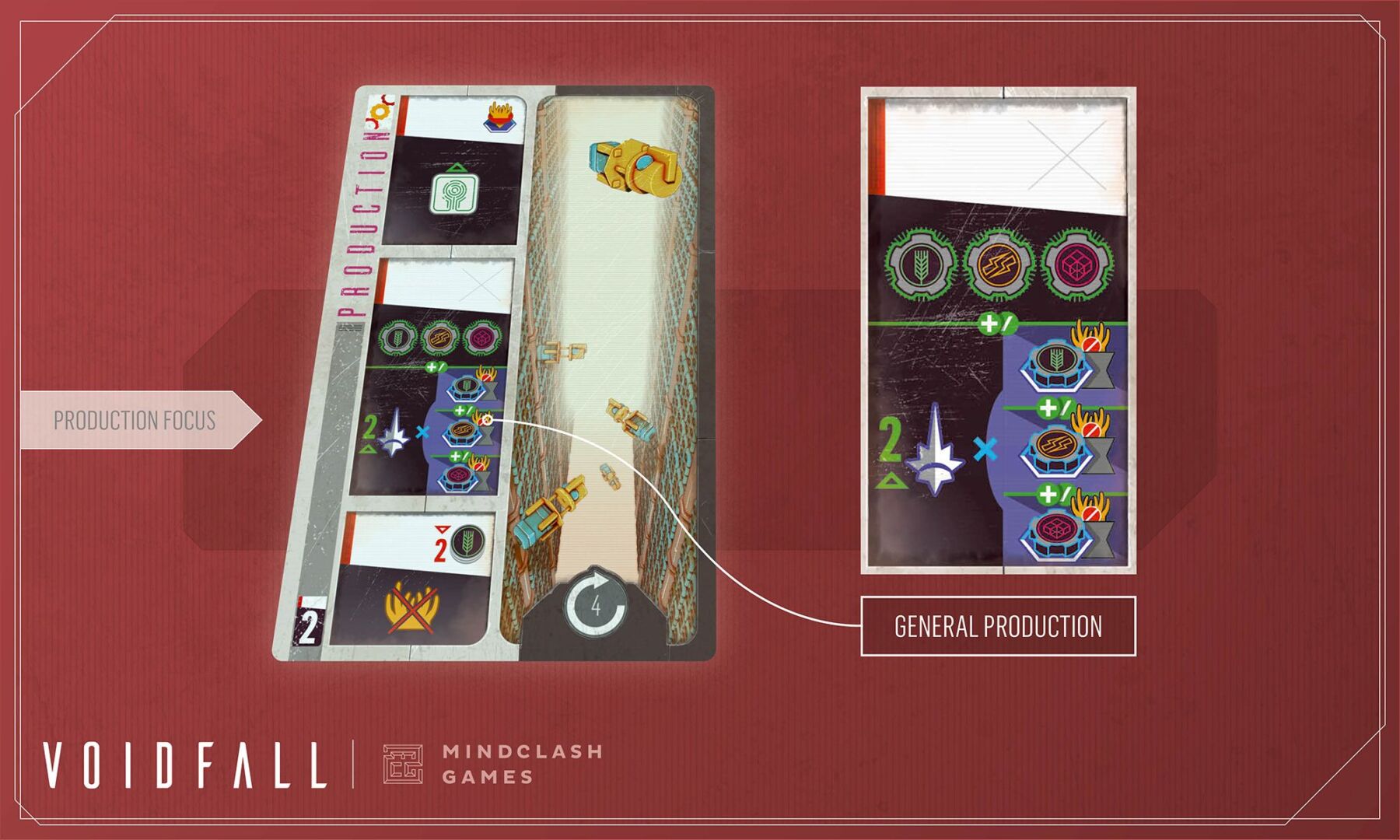
To showcase eXploit, let’s just focus on the second action, General Production. This action will add your Food, Materials and Energy production to your stockpile. Remember Population and the Guilds from the first Spotlight? This is where having populous Sectors with several Guilds pays off! In addition to the resources, becoming an economic powerhouse also gains you 2 Influence for each resource-producing Guild you have established. Once again, getting hold of some Production-focused agendas and benefitting from the fact that every resource produced over your Stockpile cap of 15 is worth half Influence, you’ve got yourself a legitimate path to victory, potentially without having to point a single gun at your opponents!
Another way you can exploit for prestige and generate further Influence is using your Bankers and the Scientist Guilds with the Prosperity Focus card.
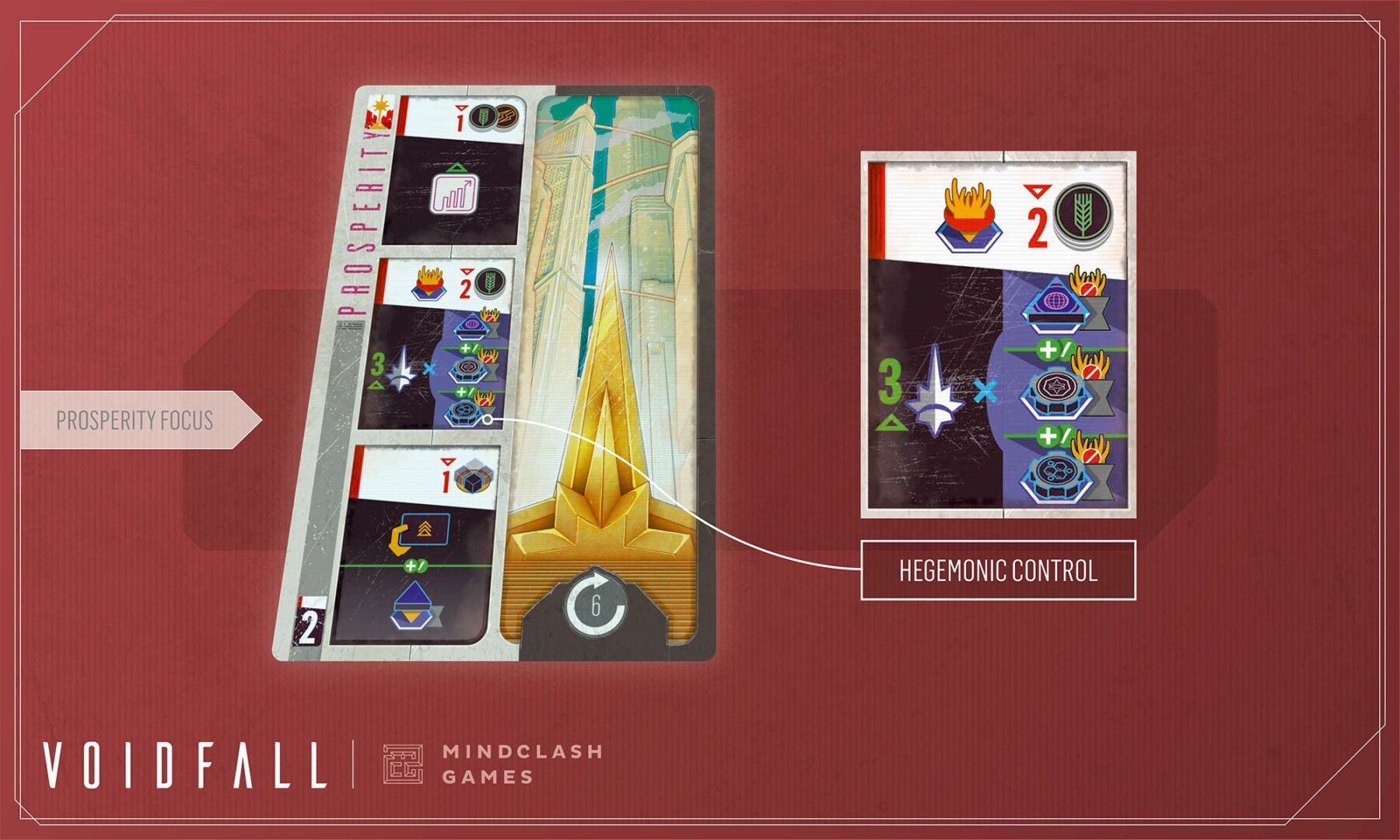
Once again, it’s the second action that’s relevant to us: Hegemonic Control gains you influence for all your Bankers and Scientist Guilds you have established along with any Starbases you may have built.
We’ve run through the most common ways to exploit the infrastructure you created within your empire: Guilds will produce resources and Influence on certain actions, and Fleet Power can be deployed via Shipyards, or relinquished to reach civic milestones with your House.
With all that said, running a galaxy-spanning star empire with billions of people doesn’t come free. You will need to maintain your investment in infrastructure and this is abstracted by the concept of Upkeep, a cost each player needs to pay at the end of each Cycle or lose Influence (and the image of a caring and capable leader).
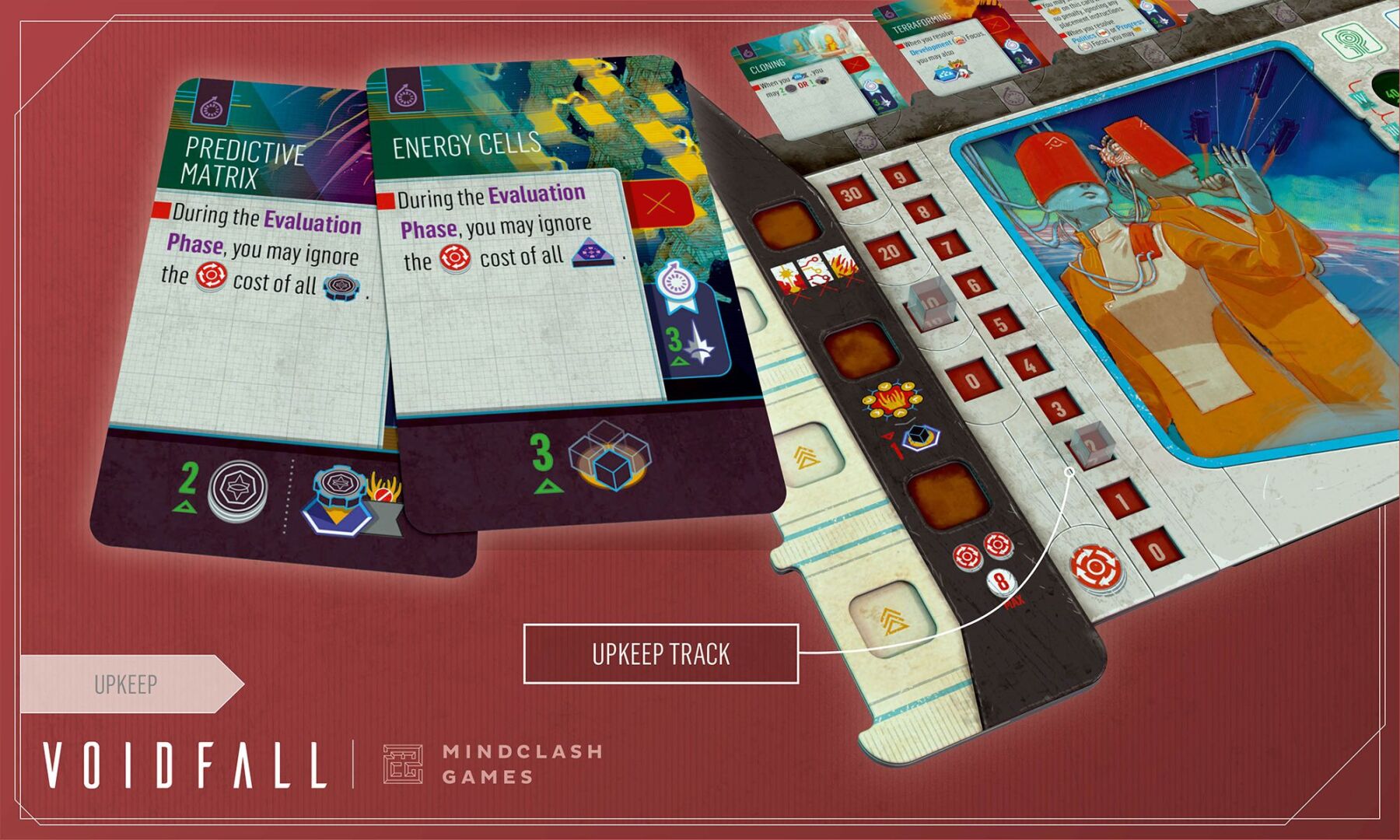
Large, capital class Fleets require upkeep, as do your Installations, your Bankers Guilds, and even some of your most powerful Techs. Agendas also have a whopping Upkeep cost of 3 due to their administrative burden, but it’s usually well worth it - as you may have seen from some previous examples, a well-built Agenda setup can turn virtually anything in the game into a legitimate win condition! There’s a silver lining too: every Trade token you own actually covers this cost, so you don’t have to worry about it until you spend said Trade token. There are several other ways to help with Upkeep, such as Techs like Energy Cells or Predictive Matrix shown above.

Now that you’ve seen all the cogs of your empire, your infrastructure, your fleets, and their usage in peace time, you are ready to face the brutal reality of war. In the next spotlights, we will cover Voidfall’s unique deterministic combat resolution and many more exciting topics!